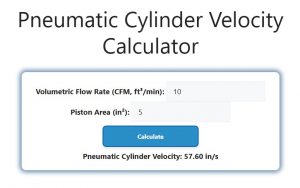About Pneumatic Cylinder Velocity Calculator (Formula)
The Pneumatic Cylinder Velocity Calculator is a helpful tool used to calculate the speed or velocity of a pneumatic cylinder. In various industrial applications, pneumatic cylinders control movement and force. This calculator helps engineers and technicians ensure optimal performance by accurately measuring cylinder speed, which is essential for efficiency and safety in pneumatic systems.
Formula
The formula to calculate pneumatic cylinder velocity is:
Pneumatic Cylinder Velocity (PCV) = 28.8 * Q / A
Where:
- PCV = Pneumatic Cylinder Velocity
- Q = Flow rate of the air or gas in cubic feet per minute (CFM)
- A = Area of the cylinder piston in square inches
This formula helps calculate the speed of the piston movement based on the air or gas flow rate and the cross-sectional area of the cylinder.
How to Use
To use the Pneumatic Cylinder Velocity Calculator, follow these steps:
- Measure Flow Rate (Q): Determine the flow rate of air or gas (in CFM) passing through the cylinder.
- Determine Cylinder Piston Area (A): Calculate or measure the area of the cylinder’s piston in square inches.
- Apply the Formula: Enter the values into the calculator, and it will compute the cylinder’s velocity.
Example
Suppose a pneumatic system has a flow rate (Q) of 10 CFM, and the cylinder piston area (A) is 5 square inches. To find the pneumatic cylinder velocity:
- Q = 10 CFM
- A = 5 square inches
Using the formula:
PCV = 28.8 * Q / A
PCV = 28.8 * 10 / 5
PCV = 288 / 5
PCV = 57.6
So, the pneumatic cylinder velocity is 57.6 inches per minute.

FAQs
1. What is pneumatic cylinder velocity?
Pneumatic cylinder velocity measures the speed at which the piston within a pneumatic cylinder moves.
2. Why is calculating cylinder velocity important?
Understanding cylinder velocity is crucial for efficient operation, ensuring the system can meet the necessary speed requirements without excess wear or air consumption.
3. How does flow rate affect cylinder velocity?
Higher flow rates increase cylinder velocity, as the cylinder receives more air pressure, accelerating piston movement.
4. What units are used in this calculation?
Typically, flow rate (Q) is in cubic feet per minute (CFM), area (A) in square inches, and velocity (PCV) in inches per minute.
5. How do I measure the flow rate for a pneumatic cylinder?
Flow rate can be measured using a flow meter attached to the air supply line leading to the cylinder.
6. What happens if I change the piston area?
A larger piston area will reduce cylinder velocity if the flow rate remains the same since a larger area requires more air to fill.
7. Can I use this formula for hydraulic cylinders?
No, this formula is specific to pneumatic cylinders. Hydraulic systems operate under different principles and require different calculations.
8. What does 28.8 represent in the formula?
The 28.8 factor is a conversion constant that adjusts for units, allowing the result to be in inches per minute.
9. Is this formula suitable for all pneumatic systems?
Yes, this formula applies to most pneumatic cylinders but assumes steady flow and ideal conditions.
10. Can this calculation affect safety?
Yes, knowing the velocity ensures the cylinder operates within safe limits, preventing excessive speed that may lead to system damage.
11. Can temperature changes affect cylinder velocity?
Yes, temperature can impact air density, thus affecting flow rate and potentially changing the velocity slightly.
12. How does air pressure impact cylinder velocity?
Higher air pressure typically increases flow rate, leading to increased cylinder velocity if all other factors are constant.
13. Are there ways to adjust cylinder speed?
Yes, speed controllers and flow control valves can be used to adjust cylinder velocity as needed.
14. Is pneumatic cylinder velocity constant?
In most cases, velocity varies slightly based on load, pressure fluctuations, and air supply stability.
15. Does cylinder bore size impact velocity?
Yes, larger bore sizes decrease velocity if flow rate remains constant since they have a larger cross-sectional area.
16. Can I calculate cylinder velocity without a calculator?
Yes, by using the formula manually, but the calculator simplifies and speeds up the process.
17. What are the typical applications for this calculation?
This calculation is common in manufacturing, robotics, and automation to optimize pneumatic cylinder performance.
18. How accurate is this calculation?
The calculation is generally accurate, but variations in air supply and pressure can cause minor deviations.
19. Is the formula affected by piston rod size?
Yes, if the piston rod size changes, it affects the piston area (A), impacting the overall velocity.
20. Can I use CFH instead of CFM in this formula?
The formula specifically uses CFM. Converting CFH to CFM would involve dividing CFH by 60.
Conclusion
The Pneumatic Cylinder Velocity Calculator is a vital tool for optimizing pneumatic systems, ensuring that cylinder velocity meets operational requirements. By calculating the speed of the cylinder based on air flow rate and piston area, engineers can control system efficiency and performance. Whether adjusting machinery speed or designing an automated process, understanding pneumatic cylinder velocity is essential for reliability, efficiency, and safety in industrial applications.